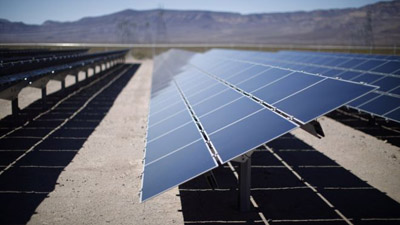March 21, 2012: Solar panels are pictured in the Nevada Desert at the Copper Mountain Solar Project in Boulder City, Nevada. (Reuters)

Firefighters across the nation are alarmed at the prospect of battling blazes in buildings topped with solar panels, which can create new risks of roofs collapsing, an inability to gain footing and even potential electric shock.
Two recent fires involving structures decked with solar panels have triggered complaints from fire chiefs and calls for new codes and regulations that reflect the dangers posed by the clean-energy devices. A two-alarm fire last week at a home in Piedmont, Calif., prompted Piedmont Fire Chief Warren McLaren to say the technology “absolutely” made it harder on firefighters. Weeks earlier, in Delanco, N.J., more than 7,000 solar panels on the roof of a massive 300,000-square foot warehouse factored into Delanco Fire Chief Ron Holt’s refusal to send his firefighters onto the roof of a Dietz & Watson facility.
“We may very well not be able to save buildings that have alternative energy,” New Jersey’s Acting Fire Marshall William Kramer told The Star-Ledger.
Experts told FoxNews.com that the biggest danger posed by the panels is that they continue to send voltage down from the roof throughout the building even after power is shut down. In a conventional building, firefighters typically cut off the electricity leading into the house before entering.
“First of all, solar panels are designed to generate electricity any time there’s light received by the panels, and that happens in low-light settings as well,” said Ken Willette, a spokesman for the National Fire Protection Association. “So inherently, those are charged electrical appliances … there’s a shock hazard.”
Solar panels also frequently utilize the very space firefighters use for rooftop ventilation during structure fires and create potentially dangerous conditions for slips and falls.
“In some applications, the solar panels have covered 100 percent of the roof, which allows the firefighter no room to operate,” Willette continued. “That’s not what you want to have happen when you’re operating on a pitched roof."
With the panels rising in popularity, firefighters and building industry experts say codes must catch up. The average price of a solar panel has declined 60 percent since 2011 and industry trade groups expect that systems will be installed, on average, every four minutes in the United States by the end of 2013, primarily in California, Arizona, New Jersey and North Carolina.
While the price of solar panels has dropped and their efficiency has increased, the U.S. still lags behind countries like Germany, Japan and Spain among solar panel installations. Swedish furniture giant IKEA also recently announced that it will begin selling residential solar panels at its stores in Britain, its first step to bring the renewable energy craze to the global mainstream market. A standard system will cost $9,200, including installation and an in-store consultation.
John Smirnow, a spokesman for the Solar Energy Industries Association, told FoxNews.com that the trade group, which represents more than 1,000 companies, is currently working with Cal Fire and the San Jose Fire Department to improve firefighter response to the systems.
“Firefighter safety is a top priority; we take firefighter safety very seriously,” Smirnow said. “They need to know what they’re dealing with. It’s critically important that firefighters know the products.”
A 2010 report by the Fire Protection Research Foundation found that slipping or tripping on solar panels were potential hazards for firefighters, as well as the possibility of the roof collapse due to the weight of the panels, which are generally made of crystalline silicon or thin-film semiconductor material. The maximum voltage of most systems, meanwhile, is roughly 600 volts, which can cause shock or burns.
“The industry has to continue to work with the fire service community, both on education and updating building codes to meet firefighters’ needs,” Smirnow continued. “That’s really where I think we can make the most progress.”
Smirnow said solar panels have only factored into a "handful" of fires to date and added that the trade group is now in discussions with national safety groups to conduct training sessions with emergency responders across the country.
“We need to understand what’s best for the fire service community,” he told FoxNews.com. "What type of education do they need? Then we’ll work with them to make that happen.”
John Smirnow, Solar Energy Industries Association
Additional Solar information via the "Fire courses, training and information facilities" section at the Kolb Website:
Photovoltaics Systems Alternative energy sources for solar roofs
Solar panel option on the roof The 2010 Prius
FF Safety / Emergency Response for Solar Power Systems Assemble and disseminate best practice information
Photovoltaic (PV) and Fire Safety UL has developed a user-friendly online training program featuring a professionally narrated description of all of the experiments, their results and the tactical considerations.
Solar Panel Safety for Firefighters The Fire Training Program at the Oregon Department of Public Safety Standards and Training (DPSST)
| ![]()




